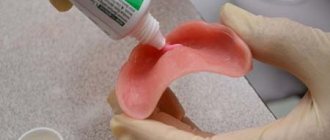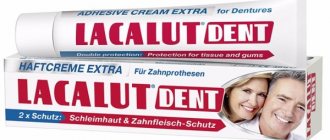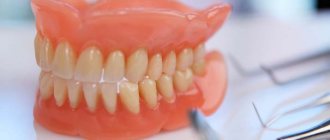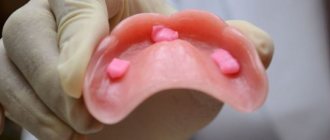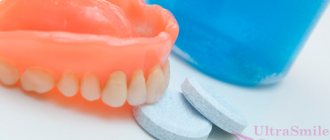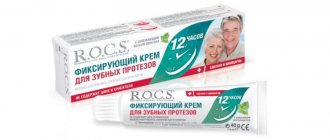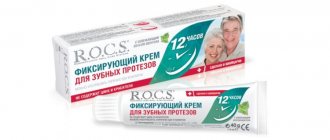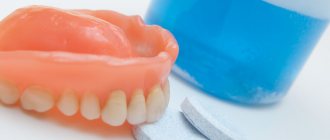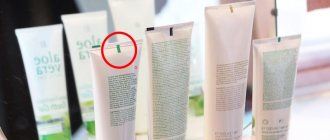The most common service in dentistry is prosthetics. If the dentist performs it correctly, a person’s teeth will become straight and their smile will be attractive. Since a large load is created on the jaw during chewing, situations may occur in which structural elements are damaged. You need to figure out how to fix a denture at home without resorting to the services of a dentist.
When to repair a structure
The materials in dentures are highly durable, but over time they can wear out or even break. Many people who use a prosthesis every day experience damage that requires emergency repairs.
There are the following reasons why device correction may be required:
- the crowns acquire a defective shade, for example, yellow or brown;
- the appearance of discomfort, pain, which previously did not bother the patient when using the structure;
- detachment, crack, puncture, peeling or other defects causing discomfort or loss of function;
- mechanical damage when clenching teeth, chewing hard elements.
If a breakdown occurs, it is better to contact your dentist directly so that he can repair the product without causing further defects. But there are times when immediate contact with a specialist is impossible. For example, if a person is away. Then temporary repairs can be done at home.
It is important not to damage the structure yourself, since repairing it will cost much less than buying a new prosthesis. There may also be breakdowns that a person cannot handle, for example, if repairs require the use of specific medical instruments.
Damaging factors
The use of dentures is very convenient for people who have lost part of their teeth or the entire dentition. This is a life-saving design, thanks to which the chewing function is fully restored. If it is installed in a timely manner, there will be no defect in the soft tissues or jaw bones. After installation, the dentist warns about the following features:
- rules of daily care;
- possible types of defects for which you will need to seek help from a dentist;
- rules for installing and removing the structure.
A small defect or complete breakdown of a denture can happen at the most inopportune moment. this :
- end of service life;
- impact on various objects, hard surfaces, which occurs when removing or installing a prosthesis;
- improper manufacturing of the system, use of low-quality materials;
- the appearance of bubbles that remain between the prosthesis and the person’s own tissues makes it difficult to use the prosthesis.
If a denture breaks, the patient may not notice it and will continue to use it. This may lead to the following consequences:
- damage to a person’s own tissues, for example, if a chip appears on the prosthesis;
- worsening defects on the prosthesis, for example, a small crack can lead to a complete split of the structure.
Both part of the structure and the entire product may break. It all depends on the extent of the damage. It is necessary to quickly make a decision on the repair method in order to prevent complications and maintain the integrity of the structure.
Fixation of dentures: methods and convenience
The convenience of using a denture largely depends on correct fixation.
To achieve this, orthodontists try to achieve maximum compliance of the inner surface of the prosthesis with the shape of the patient’s alveolar process. As a rule, such structures usually have special fixing elements. However, they cope with the problem of fixing the prosthesis at rest. But when chewing or talking, the structure may fail due to increased load. Therefore, for better fixation of such devices, special means are used.
Depending on how many teeth a person is missing, doctors recommend the installation of full or partial dental restorations. Removable structures are mainly made of plastic in combination with other materials. Each type of such devices has its own characteristics of fixation. In addition to clasps (or brackets) and attachments (clasps), special means are used to secure dental structures, presented in the form of:
- cream or gel;
- glue;
- stripes;
- powder.
Fixatives are usually made from plant or animal products. They are saturated with saliva and increase in volume, forming a layer between the plastic base and the mucous membrane that provides high adhesion force for the prosthesis.
Also, fixation means prevent food debris from getting under the prosthesis, and also facilitate the process of adaptation to the prosthesis and tissue healing after its installation.
Recovery Features
Many people are afraid to go to the dentist when defects appear, because they believe that repairs will be expensive. But it is better to repair a small defect in a timely manner than to completely replace the structure. Features of the restoration of the product depend on the cause of the damage and the degree of development of the defects. The recovery method takes place in stages:
- Removal and inspection of the structure
. If there are particles of dirt on the surface, the structure is completely cleaned. - Uses of Dental Resin
. Damaged particles stick together to create a sealed state. You can achieve an appearance that does not differ from the original quality. - Evaluation of the shade of the structure
. Its color is affected by drinking caffeine and strong tea, and smoking cigarettes. If contamination is detected, the surface must be cleaned. This should only be done by a dentist using specialized medical solutions. He will achieve the original, ideal shade of the crowns. - Chips of a small part or the entire crown
. There is no need to worry about this; even if a large part of the column breaks off, it can be restored. For this purpose, they turn to a dental technician to strengthen the broken product into place.
If a piece breaks off from a denture, you should not throw it away. Together with him, they contact a dentist or dental technician, he will help restore the integrity of the structure.
What affects the quality of fixation of dentures in the oral cavity?
No matter how high-quality the removable appliance is initially, its functionality after installation is measured by the comfort of wearing for the patient and the ability to replace lost teeth as much as possible, restore chewing function and aesthetics of the row.
%akc61%
What affects the fixation of dentures? There are factors that influence the fixation and position of artificial devices in the oral cavity, which must be taken into account when creating a design:
- anatomical features (“relief”) of the alveolar ridge, palate and prosthetic bed. The vertical shape of the gums is more conducive to retaining the structure than flat, mushroom-shaped or sharp ones.
- interaction of the apparatus when chewing with the inside of the cheeks, lips, their holding ability or, conversely, the possibility of displacement during muscle movement,
- the position, size and mobility of the tongue, under which a bed is formed in mandibular complete dentures. The tongue can also both hold the structure in place and move it,
- uniform distribution of load on the bed,
- absence of pre-contacts: the teeth of one side of the device should not come into contact with the opposite ones before the other side. In this case, the device cannot tip over,
- correct position of artificial teeth along the axis.
The quality of fixation and stabilization of removable dentures determines the effectiveness of orthopedic treatment1. Experts evaluate the quality of fixation using the Ulitovsky-Leontiev index, which describes more than 10 fastening parameters.
Bonding materials
In the process of creating a crown, only materials with a high degree of strength are used. But even in this case, small chips and cracks are possible. You can eliminate them yourself. But it is important to understand that home renovations are only a temporary measure. As soon as the patient has the time and opportunity, he should see a dentist.
If repairs are initially carried out at home, dentists give the following recommendations:
- Preheat the device to allow the wax to melt. This technique is typical only for removable structures, so as not to damage a person’s own tissue.
- Giving the correct shape to the gypsum base. It should be cone-shaped. To change the shape, the prosthesis is repeatedly exposed to heat.
- When the device has cooled, the gluing area is treated with sandpaper so that there are no rusty particles left on the surface that scratch the gums.
- Fastening the fallen part of the crown to the structure. It is important to place it in the exact location, not to mix it up, otherwise severe discomfort will occur.
- Bonding the crowns and the base of the structure using wax or other auxiliary material. The glue must be reliable, but safe, it must not damage the device.
- Wait for the structure to dry and cool. The adhesive substance should not get on the soft tissues in the person’s mouth. The remaining excess wax that has spread around the edges is removed.
Bonding may require more than just wax. To achieve a more stable fixation, it is recommended to purchase special glue from a dental store. It is intended specifically for dentures. Once glued, the device can be reused, but it is important to understand that this will not last long. The structure glued in this way can be damaged again, so it is important to consult a doctor in a timely manner. It is unacceptable to further damage the system during repairs, otherwise restoration of integrity by the dentist may not occur.
Removable denture repair
To carry out the repair procedure yourself requires skill and a little experience. The patient must decide whether he can eliminate the defect on his own, or whether it is better to go straight to the dentist. There are certain risks in the process of such actions:
- greater damage to the device;
- improper repair leading to malocclusion;
- the presence of chips and rough surfaces that cause damage to adjacent soft tissues.
If you repair the product yourself, you may not be able to fully restore its functionality.
If you contact a professional dentist and dental technician in a timely manner, the product can be completely repaired in a few days and its functions will be restored. The integrity of the structure is restored in full. To do this, dentists follow step-by-step instructions in restoring the integrity of the prosthesis using medical equipment.
Repair instructions for plate dentures:
- Detection of a defect, application of the damaged structure to the location. Fixation is carried out using sticky wax or medical glue.
- Application of an insulating agent. It is installed from the side of the prosthetic bed. This prevents the plastic structure and plaster from sticking together. You cannot do this with your hands; use a brush or brush.
- Formation of a fixing model from plaster. Only top class materials are used. The denture needs to be divided and the fracture lines processed with a micromotor or cutter. Individual parts of the structure are installed using a fixing model. The dentist ensures that the distance between the fixation models in the area of the fracture does not exceed 3 mm.
- Forming a fold. The bevel angle should be 45° in relation to the base of the device. This will create a smooth transition between the old and new areas of plastic. They will be connected in a better shape.
- Application of an insulating agent. It is used on the surface of plaster so that the adhesive material does not absorb liquids spreading from plastics. Otherwise, large pores will form. As soon as the parts of the prosthesis have been fixed with monomer, they begin to knead the plastic. This action occurs in stages.
- The plastic prepared according to plan should swell. It is transferred to the prosthetic areas with a reserve. Then press a little with your fingers. The resulting product is transferred to the apparatus to polymerize the plastic.
At the final stage, excess plastic must be removed. For this purpose, a micromotor and a press are used. The surface is leveled with medical instruments intended for grinding. After polishing the surface, the product is treated with antiseptic solutions. It is ready to use.
Indications for the use of fixing materials
Many people ask whether it is always necessary to use additional means to fix dentures? Most often, such means are used:
- for the reliability of using the prosthesis (to facilitate biting and chewing food, to eliminate the fear of losing the prosthesis when speaking);
- people whose profession involves increased demands on appearance or voice (teachers, musicians, speakers);
- with dry mouth due to diseases (stroke, etc.) or taking certain medications, in elderly patients.
Recovery technique in the clinic
At the dental clinic, the doctor initially examines the device visually. It should be examined by a dental technician. If pieces of food and other foreign objects are stuck in the denture, pre-clean it. Only after this can you accurately see all the defects and begin the restoration of the structure. If you exclude the cleaning step, the adhesive will not be able to completely fix the broken product. Then the repair procedure will be ineffective. Only after cleaning can high-quality sealing be achieved.
If the defects in the device are excessively large, the dentist will recommend completely replacing the structure. This is due to the following features:
- saving money, since repairs may require similar financial resources as major repairs;
- the possibility of a lack of quality effect during repairs; the base will continue to break, damage tissues, and disrupt the bite.
Only if minor chips or cracks appear on the prosthesis, it can be restored. For example, if a small chip occurs on the crowns, remove the device and fix it. Why install the crown in place? The result should be a product that is not inferior in function to new prostheses.
Many patients believe that they can handle the repair themselves. But there is a big difference between home bonding and professional services. At home, you can make a little adjustment to the design before going to the dentist. Complete repairs can only be carried out by a competent dental technician. He must have specialized tools at hand in order to carry out high-quality restoration.
The patient does not have solutions or tools at home that will return the whiteness to the crowns on the prosthesis. Periodically, it is necessary to restore the shade in order for the prosthesis to perform an aesthetic function. It should completely replace the appearance of real teeth.
It is not always possible to achieve high-quality restoration after repair, even from a dentist. For example, if a stamped device or a product without metal is damaged, it cannot be repaired.
Repair price
The cost of restoring the quality of a denture after repair depends on the following factors:
- the complexity of the work performed by a dental technician;
- product material;
- area and degree of damage.
For example, if a patient’s metal-ceramic structure is slightly broken, repairs can reach up to 2,000 rubles.
The following approximate price list is highlighted:
- installation of a new artificial crown - 2500 rubles;
- professional cleaning and whitening of crowns, basics of the device - 1000 rubles;
- restoration of crown shade when drinking coffee, after prolonged smoking - 1200 rubles.
If you carry out the restoration yourself, the price will be significantly lower, but the entire structure will not be able to regain its original appearance. The damage may recur or continue to get worse.
Creams and gels
Fixing a denture with cream or gel, which to choose? Both of these remedies are identical in their effectiveness and method of use. The only difference between them is the greater fluidity of the gels with the ability to form a thinner layer. Creams have a denser consistency and contain an additive of aromatic oils.
Rules for the use of gels and creams for dentures
Typically, experts recommend using creams to fix dentures immediately after prosthetics because of their ease of dosing and use.
But the amount of gel is more difficult to correctly calculate. If you increase its amount, the gel will not harden and hold the prosthesis normally.
Creams are applied to the lower segment of the denture, which is then pressed firmly against the gums. The creams reliably fix the structure for 12-24 hours.
The cream is especially recommended for patients with excessive salivation.
The most common and high-quality fixation creams are Rocs, Lacalut, Protefix, President, Corega, etc.
To choose the right means of fixation, you need to know such subtleties
- It is better to choose gels and creams with neutral scents. Fragrances in them are contraindicated for people with allergies.
- Preference should be given to waterproof products due to their longer action and better tightness. Waterproof types of compositions better protect against the penetration of food under the prosthesis and the development of unpleasant odors or inflammation.
- It is better to avoid using products containing zinc due to its toxic effect on the body (nervous and skeletal systems).
- Products with a gel-like consistency are more economical due to the ability to form a thinner layer during fixation.
